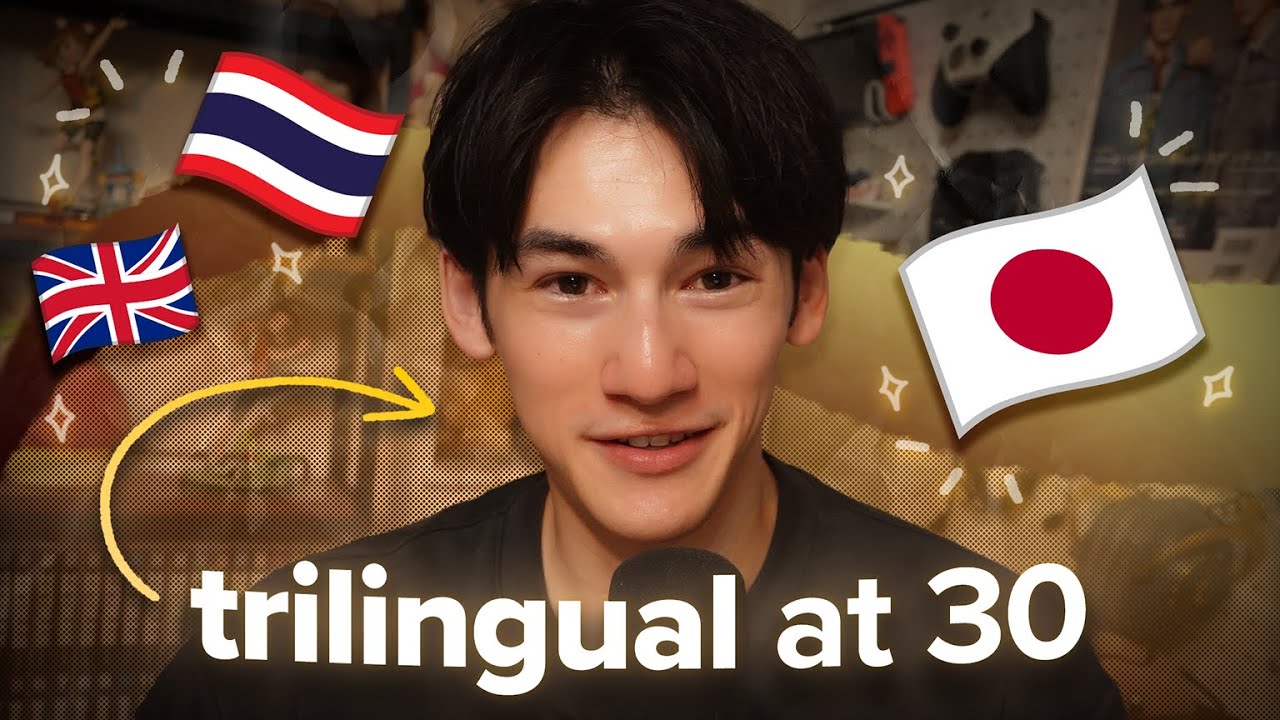How to start learning THAI from zero (tips + resources)
Summary
TLDRIn this video, LinnLett shares her Thai learning journey, from her initial decision to study Thai for a scholarship in Thailand to mastering the language's script and tones. She highlights the importance of immersing oneself in the language through songs, dramas, and conversations, and emphasizes starting with basic phrases and functional words. LinnLett offers valuable tips on learning effectively, avoiding unnecessary grammar stress, and focusing on practical vocabulary and sentence structures. Her experience proves that consistency, patience, and immersion are key to mastering Thai and gaining confidence in real-life conversations.
Takeaways
- 😀 Start by getting familiar with the sounds and rhythm of Thai through songs and dramas to make the learning process feel natural.
- 😀 Learn the Thai script early, focusing on consonants and vowels (44 consonants and 24 vowels).
- 😀 Practice tone rules early, as Thai has a tonal structure that impacts pronunciation and meaning. Focus on the mid, high, and low tone classes.
- 😀 Learn basic phrases for daily life before diving into grammar, such as greetings and simple expressions like 'thank you' and 'I don't understand'.
- 😀 Understand that Thai sentence structure is similar to English (subject > verb > object), but there are no tense conjugations in verbs.
- 😀 Avoid overwhelming yourself with too much grammar upfront; focus on functional words, basic sentence structures, and real conversations.
- 😀 Focus on practical vocabulary that appears in daily conversations, like pronouns, question words, and common verbs, rather than memorizing random nouns.
- 😀 Don’t memorize vocabulary in isolation; learn words in full sentences to understand their context and usage.
- 😀 Start speaking Thai as soon as possible, even with only a few words. Practice speaking out loud daily to get used to producing the sounds and tones.
- 😀 Stay consistent, set clear goals, and celebrate small milestones along the way to build confidence and fluency in Thai.
Q & A
Why did LinnLett decide to start learning Thai?
-LinnLett decided to learn Thai after applying for a scholarship in Thailand. She realized that knowing some basic Thai would be essential for living and studying there, even in an international program.
What was LinnLett's first step in learning Thai?
-LinnLett's first step was to familiarize herself with how Thai sounds and flows. She listened to Thai songs, watched Thai dramas, and vlogs to help her brain recognize the rhythm, common words, and tone patterns.
How did LinnLett approach learning the Thai script?
-LinnLett began by learning the Thai script, focusing on the 44 consonants and 24 vowels. She used resources like a Myanmar-based exercise book and the 'Learn Thai with Son Jai' YouTube channel to practice pronunciation and phonetics.
What was the challenge in learning Thai tones, and how did LinnLett tackle it?
-Learning Thai tones was challenging due to the five-tone system. LinnLett grouped the consonants by tonal class (low, mid, high) and practiced intensively until she could recognize the tone of any given word. She followed a step-by-step approach starting with mid-class tones and then moving to high and low-class tones.
What role did basic phrases play in LinnLett's language learning process?
-LinnLett started with basic phrases, such as greetings and simple expressions, which helped her feel confident and motivated early on. This approach also allowed her to practice speaking Thai in everyday situations without worrying too much about perfect pronunciation.
How does Thai sentence structure compare to English and Chinese?
-Thai follows a subject-verb-object (SVO) structure, similar to both English and Chinese. However, Thai does not change verbs for tenses like English does. Instead, time indicators such as 'yesterday' are added to indicate when an action occurred.
What are some of the key differences between learning Thai and other languages?
-One key difference is that Thai does not have verb conjugations, tense changes, or gendered nouns like many other languages. This makes the grammar simpler, allowing learners to focus more on vocabulary and sentence structure.
Why is immersion important in learning Thai, according to LinnLett?
-Immersion is important because it helps learners train their ear to recognize the different tones and sounds of Thai. LinnLett found that listening to Thai conversations, watching Thai media, and practicing with native speakers were the most effective ways to learn.
What resources helped LinnLett the most during her learning journey?
-LinnLett found the 'You Too Can Learn Thai' YouTube podcast channel particularly helpful for listening practice. The channel provides clear and gentle lessons along with transcripts, making it easier to follow and understand.
What mistakes did LinnLett avoid during her language learning process?
-LinnLett avoided diving too deep into grammar too early, focusing instead on basic sentence structures and functional words. She also recommended not memorizing too many words at once and emphasized learning phrases instead of isolated words.
Outlines

Этот раздел доступен только подписчикам платных тарифов. Пожалуйста, перейдите на платный тариф для доступа.
Перейти на платный тарифMindmap

Этот раздел доступен только подписчикам платных тарифов. Пожалуйста, перейдите на платный тариф для доступа.
Перейти на платный тарифKeywords

Этот раздел доступен только подписчикам платных тарифов. Пожалуйста, перейдите на платный тариф для доступа.
Перейти на платный тарифHighlights

Этот раздел доступен только подписчикам платных тарифов. Пожалуйста, перейдите на платный тариф для доступа.
Перейти на платный тарифTranscripts

Этот раздел доступен только подписчикам платных тарифов. Пожалуйста, перейдите на платный тариф для доступа.
Перейти на платный тарифПосмотреть больше похожих видео

Why This Thai/Swedish Girl Loves Thailand? 🇹🇭

My Advice For Learning Languages As An Adult

Thai Prostitute interview-Tuk

Behind The Smile: A Thai Woman's Take on Certain Foreigners Who Visit Thailand @MynamesEARN

I Live Better In Thailand Than I Did In The U.S. - Here's How Much It Costs | Relocated

Journey to UFC - Day 146
5.0 / 5 (0 votes)
